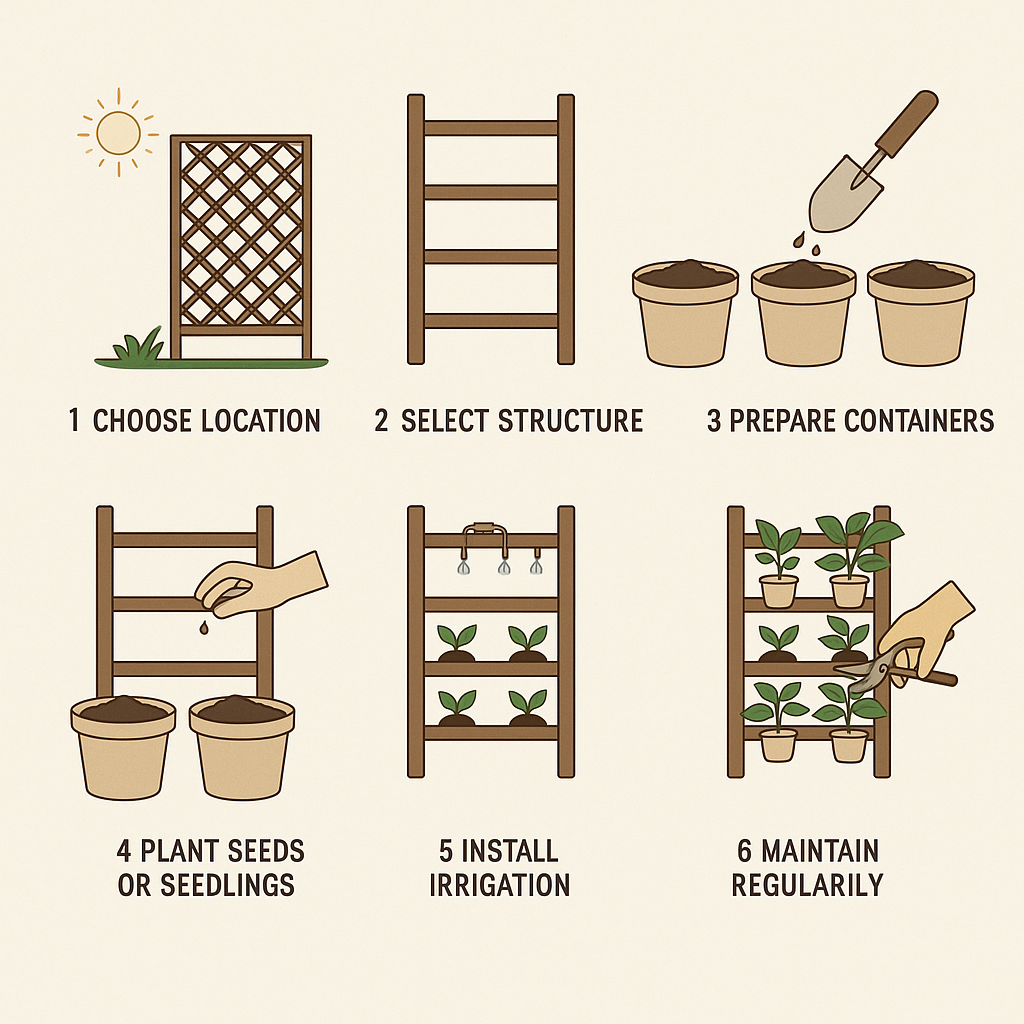Vertical gardening ideas are transforming how people grow plants, especially in urban spaces where ground area is limited. By making the most of vertical space—walls, trellises, shelves, and towers—you can increase yields, improve air circulation, and turn even the smallest balcony into a lush green haven.
In this guide, you will discover practical vertical gardening concepts, the best plants for vertical growth, and step-by-step strategies to start your own vertical garden successfully.
Why Vertical Gardening is Perfect for Small Spaces
Vertical gardening allows you to grow more in less space, which is ideal for:
- Apartment balconies
- Small backyards
- Indoor gardens
- Rooftop gardens
Key Benefits:
- Maximizes space: Uses unused wall or fence surfaces for planting.
- Reduces pests and diseases: Plants are elevated, which improves airflow.
- Adds beauty: Creates green walls that enhance your home’s aesthetics.
- Easier maintenance: Reduces the need for bending and kneeling compared to traditional gardening.
Moreover, vertical gardening can also help create privacy screens and act as natural sound barriers in noisy neighborhoods.
Step 1: Choosing the Right Vertical Structure
Selecting the right structure is essential for vertical gardening success.
Popular Options:
- Trellises: Excellent for climbing plants like cucumbers and beans.
- Wall planters: Perfect for herbs and small flowers.
- Vertical towers: Suitable for strawberries, lettuce, and leafy greens.
- Hanging baskets: Great for trailing plants such as cherry tomatoes or petunias.
- Shelving units: Ideal for potted plants indoors.
💡 Tip: Recycled wooden pallets provide an affordable and stylish base for a vertical garden while reducing waste.
Step 2: Selecting Plants for Vertical Gardening
Not every plant is suitable for vertical growth. Therefore, focus on lightweight or climbing varieties to ensure stability.
Best Choices:
- Climbers & Vines: Peas, beans, cucumbers, morning glories.
- Compact Vegetables: Lettuce, spinach, radishes.
- Herbs: Basil, thyme, oregano, parsley.
- Strawberries: Thrive in vertical pockets or towers.
- Trailing Flowers: Nasturtiums, petunias, sweet alyssum.
Additionally, mixing edible plants with ornamentals can create a visually appealing and functional display.
Step 3: Soil and Watering Needs
Soil:
- Choose lightweight potting mix to reduce stress on vertical structures.
- Enrich the soil with compost for improved nutrient retention.
- Avoid heavy garden soil, as it can compact and limit drainage.
Watering:
- Vertical gardens dry out faster because of increased exposure.
- Install a drip irrigation system for consistent moisture delivery.
- Water from the top, allowing gravity to help distribute moisture downward.
As a general rule, check the soil moisture regularly to avoid under or overwatering.
Step 4: Planting Techniques for Vertical Success
- Plan the layout: Position heavy plants at the bottom and lighter plants higher up.
- Space accordingly: Follow plant spacing guidelines to prevent overcrowding.
- Use strong supports: Secure trellises and frames to avoid tipping.
- Mix textures: Combine leafy greens with flowering vines for a lush, layered appearance.
By planning ahead, you ensure both aesthetics and functionality.
Step 5: Light Requirements
- Full Sun Plants: Tomatoes, cucumbers, and strawberries need 6–8 hours daily.
- Partial Shade Plants: Spinach, lettuce, and mint thrive with 3–4 hours of indirect light.
- For indoor vertical gardens, consider full-spectrum grow lights to maintain healthy growth.
Furthermore, rotating plants occasionally helps them receive even light exposure.
Step 6: Maintaining Your Vertical Garden
- Prune regularly: This keeps plants healthy and encourages new growth.
- Fertilize every 4–6 weeks: Organic liquid fertilizers are ideal for quick nutrient absorption.
- Check for pests: Inspect leaves frequently for aphids, spider mites, or fungal spots.
- Rotate crops: This reduces the risk of soil-borne diseases building up over time.
Consistent maintenance not only extends plant life but also enhances productivity.
Creative Vertical Gardening Ideas to Try
1. Pallet Herb Garden
Attach geotextile fabric to the back of a pallet, fill it with soil, and plant herbs in the slats.
2. Hanging Gutter Planters
Hang cut sections of rain gutter for shallow-rooted plants like lettuce and strawberries.
3. Bottle Tower Garden
Stack recycled plastic bottles, each acting as a planting pocket.
4. Green Wall Panels
Install modular panels with built-in irrigation for a stunning living wall indoors or outdoors.
5. Repurposed Ladder Planter
Lean an old ladder against a wall, using each rung to support planters.
Each of these ideas is budget-friendly and adaptable to various spaces.
Step-by-Step: Setting Up a Basic Vertical Garden
- Choose location: Ensure adequate sunlight for your chosen plants.
- Select structure: Pick trellises, shelves, or wall-mounted planters based on needs.
- Prepare containers: Add lightweight potting mix with compost.
- Plant seeds or seedlings: Follow depth and spacing guidelines.
- Install irrigation: Drip systems save both time and water.
- Maintain regularly: Prune, water, and feed plants consistently.
For creative ways to garden in small rented spaces, check out our full guide here.

Conclusion
Vertical gardening is a practical and beautiful way to grow more food and flowers in limited space. With the right structure, plant selection, and care routine, you can transform a bare wall or corner into a thriving green space.
🌱 Save this guide for your next planting weekend! And share it with a friend who loves gardening but struggles with space.
FAQs
1. Can I grow vegetables vertically indoors?
Yes. Use compact varieties, adequate lighting, and lightweight planters to create an indoor vertical garden.
2. How do I prevent water from dripping onto floors or balconies?
Install trays at the bottom of your vertical garden or use self-watering planters.
3. What’s the cheapest way to start a vertical garden?
Repurposing pallets, ladders, or gutters is an affordable and eco-friendly option.
Looking for durable trellises and wall planters? You can explore a wide range here on Amazon.
Written by Kate Smith | Plant Care Enthusiast & Urban Gardener
